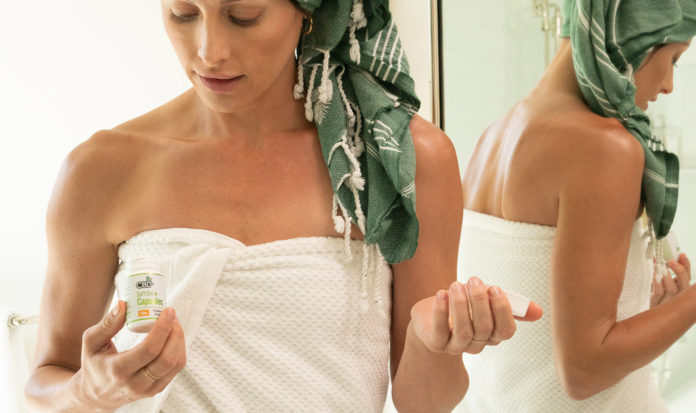If you’re new to hemp wellness products, you should know how to read a CBD product label.
Knowing what’s in your supplements makes it easier to make informed decisions about what to use and where to buy it.
Sure, reading a CBD product label isn’t rocket science—they’re easy to understand once you have some idea of what each term means, so let’s look at how to do it.
Knowing Your Cannabinoids
CBD is just one of many different cannabinoids that grow in the cannabis plant. These compounds give the plant its wellness properties, and they each affect the body in unique ways.
THC is the most well-known cannabinoid since it’s the one that gets people high when using marijuana. Unlike marijuana, though, hemp plants contain minimal THC.
In the U.S., hemp crops can have no more than 0.3% THC content.
While any hemp product usually contains traces of all the cannabinoids, most supplements only contain a few.
Products like our CBD + CBG Wellness Tincture contain a 2:1 ratio of CBD to CBG, meaning that there is twice as much CBD as CBG.
Other products will contain cannabinoids like CBN to round out the effects and give you a better overall experience.
Why More Is Better
All mammals have an endocannabinoid system (ECS) in their body—that includes you.
When cannabinoids enter the bloodstream, the ECS triggers activity from your brain down to your stomach, and each cannabinoid works a little differently.
For example, CBD works by weakening enzymes so that your ECS can keep producing endocannabinoids for longer periods. CBD cannot bind to the ECS, so it works by keeping other systems from shutting it down.
On the other hand, CBG does bind to ECS receptors. This allows it to have a more direct effect on your body. Some say that CBG is the ultimate cannabinoid since it is the beginning of all other cannabinoids, with a short window of harvest time in the hemp plant’s growth cycle.
While scientists haven’t figured out exactly how the ECS works with cannabinoids, we know that it’s better to have more cannabinoids in a product.
Other Plant Materials
Cannabinoids aren’t the only things that grow in the hemp plant. The plant has to smell and taste nice to attract predators that will eat the plant’s flowers and spread seeds elsewhere.
That’s where terpenes come in.
Terpenes help give hemp its unique scent and flavor. Whenever you walk through an orange grove and smell that crisp citrus air, you’re experiencing terpenes.
However, terpenes do more.
When combined with cannabinoids, terpenes help your body absorb the promising compounds that help your ECS kick into gear more easily.
They also enhance the effects of cannabinoids by performing the same tasks, such as reducing inflammation and anxiety.
Look for terpenes on your CBD product label. For the most part, you’ll find terpenes in higher quality products. That’s not to say all high-quality CBD oils contain terpenes, just that low-quality ones usually won’t.
Percentage of Cannabinoids in Your Supplement
Now that you know a little about which cannabinoids are in your product, the next thing is to figure out the quantities included.
Because everyone is different, there’s no one serving that fits each person’s lifestyle. Some need more, others need less, and figuring out the perfect amount is up to you. Start with around 20 mg of CBD and see how that works out for you.
If it doesn’t work as well as you’d like, wait until the next day and increase the serving to see how it goes. At some point, you’ll find what you want, and then it’s smooth sailing from there.
Depending on the product you use—tincture oils, gummies, capsules, etc.—serving sizes will be different. While each CBD gummy is measured for a specific amount, tincture oils need you to do a little math.
Tincture oils come with a 1 mL dropper, so the label should tell you how much of a given product per serving. If you can’t find that info on the label, just divide the CBD mg by the bottle size to determine how much is in each dropper.
It’s not hard—don’t worry.
Check to see how many cannabinoids are in your supplement.
Other Stuff to Look For
The way cannabinoids get into your body is just as crucial as the compounds themselves.
One problem with cheap, low-quality products is that the CBD isn’t readily available to the body.
Molecules can be a little weird. Bigger ones can be harder for your body to absorb, while the smallest ones can be volatile due to their size. MCT oil is used to make it easier for your body to absorb CBD and other cannabinoids.
MCT stands for medium-chain triglyceride. It is a molecule used to make it easier for your body to take in food and put it to good use, so when it’s combined with CBD, it makes for a more effective supplement.
There are CBD products for all kinds of different lifestyles. You can find everything from CBD daily multivitamins to joint and muscle creams.
These products usually include other products such as essential oils, natural anti-inflammatories, and even protein sources like spirulina.
However you live your life, there’s a perfect CBD product out there just for you.
Ensuring Product Quality
For those who like to read everything they can about a product, the next place to check is a lab report. These are third-party test results that show both what’s inside a product and what’s not.
For example, you’ll know if a grower used synthetic pesticides or fertilizers during the farming process. You’ll also know if there are any leftover solvents from when the cannabinoids were extracted from the plant. Lab reports even check for mycotoxins which can grow like fungus on a hemp plant.
Plus, not all vendors offer lab reports to their customers. If your vendor has something like this for you to read, it’s usually a good sign that they provide high-quality products you can count on.
Finding a vendor you can trust can take time. The more products they offer, the higher the chance is that those products will work well.
Try out a few different things and see how they work for you.
Ready to shop our giant selection of organic CBD products?
Click here to see our inventory.

